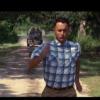I've seen a hand close up, though I was groggy at the time. I've mentioned that I was wakened by our puppy in 1974. It had pressed up against my head, shivering in fright as a bigfoot was attempting to grab it by reaching into the tent. My first impression was that someone was sticking a large branch with a glove on the end of it inside our tent. The arm was six feet in length. The thumb of the glove cupped inwards, as I recall, rather than forming a plane with the palm. As I woke and spoke to the puppy it began to withdraw it's arm giving me a view of the hand from about twelve inches. The puppy then passed in front of my face, burrowing into my sleeping bag and obstructing my view. When I looked back for the branch and hand it was gone, so I thought I had dreamt it and that the puppy was simply shivering from cold. When I realized that my exposed shoulders weren't cold, adrenalin kicked in and I looked around to find a hulking shadow outside the tent at my feet. After a staring match through the wall of the tent, I decided that the motionless shadow was cast by a boulder from reflected moonlight from the lake and laid back down. As soon as I did, the bigfoot stood up, gave a disgusted "humph" and walked away, passing directly between the full moon and the tent, casting a huge shadow across the top of the tent, which was five feet in height. The hand had black hair fringing it from the back and was lighter tan color on the palm and inner surface of the fingers. It was a full moon with ambient light shining through the roof of the tent.



